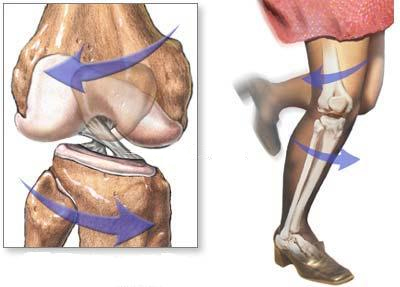The anterior cruciate ligament is the most important intra-knee ligament that limits the knee forward and rotational rotation. Although anterior cruciate ligament injuries are often associated with sports injuries, it is also a ligament that is frequently damaged in non-sports injuries.
The injury usually occurs as a result of the trunk rotating without a direct blow to the string, but the leg is unable to rotate simultaneously at the same time.
The injury usually occurs as a result of the trunk rotating without a direct blow to the string, but the leg is unable to rotate simultaneously at the same time.
The patient expresses that there is a serious rupture from the knee at the time of the incident, and in some cases even from outside. The most common symptoms are sudden swelling, pain, and limitation of movement in the knee after the event. Most of the time there are no problems with x-rays taken on knees.
Diagnosis is made especially by examination and MR taken after the knee swelling regressed.
Diagnosis is made especially by examination and MR taken after the knee swelling regressed.
After anterior cruciate ligament injuries, knee rest, ice application and bandage are recommended. There is significant relief in the knee within 10-15 days, and the patient often thinks that the knee is back to normal, but it should be noted that the knee without anterior cruciate ligament is no longer a normal knee.
So what to do in the treatment? The most important determinants here are the patient's age and activity status. Repair of the anterior cruciate ligament is a primary treatment, especially in a young patient with an expectation of sports. However, not every anterior cruciate ligament injury is operated. Satisfactory results can also be obtained by methods such as physical therapy protocols and increasing muscle strength. The most common complaints in the knee after anterior cruciate ligament rupture are feelings of discomfort in the knee, complaints of knee rotation and pain. In patients who complain about these conditions, the surgical option now comes to the fore. It should not be forgotten that the knees without anterior cruciate ligament repair, that is unstable, are susceptible to injuries such as meniscal tear, cartilage damage, and the timing of the operation should be correct. The operation is performed today with a closed method called arthroscopic repair. It is made by fixing the tendons taken from the back of the knee with special materials after passing them through the holes opened to the knee bones.
So what to do in the treatment? The most important determinants here are the patient's age and activity status. Repair of the anterior cruciate ligament is a primary treatment, especially in a young patient with an expectation of sports. However, not every anterior cruciate ligament injury is operated. Satisfactory results can also be obtained by methods such as physical therapy protocols and increasing muscle strength. The most common complaints in the knee after anterior cruciate ligament rupture are feelings of discomfort in the knee, complaints of knee rotation and pain. In patients who complain about these conditions, the surgical option now comes to the fore. It should not be forgotten that the knees without anterior cruciate ligament repair, that is unstable, are susceptible to injuries such as meniscal tear, cartilage damage, and the timing of the operation should be correct. The operation is performed today with a closed method called arthroscopic repair. It is made by fixing the tendons taken from the back of the knee with special materials after passing them through the holes opened to the knee bones.
Average hospital stay is 2-3 days. The patient can start walking immediately after discharge. After the control of pain and edema in the first days after the operation, physical therapy should be started as soon as possible. One of the most important parameters that determine the success of the operation is the compliance with the exercise program to be performed by the patient after the operation.
Desk workers are usually able to work for 10 days. Light straight runs are generally allowed in the 3rd month after surgery. The average time to return to sports in professional athletes is 6 months, and this period is extended to 1 year in amateurs.
Desk workers are usually able to work for 10 days. Light straight runs are generally allowed in the 3rd month after surgery. The average time to return to sports in professional athletes is 6 months, and this period is extended to 1 year in amateurs.




